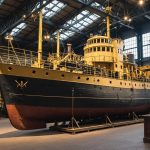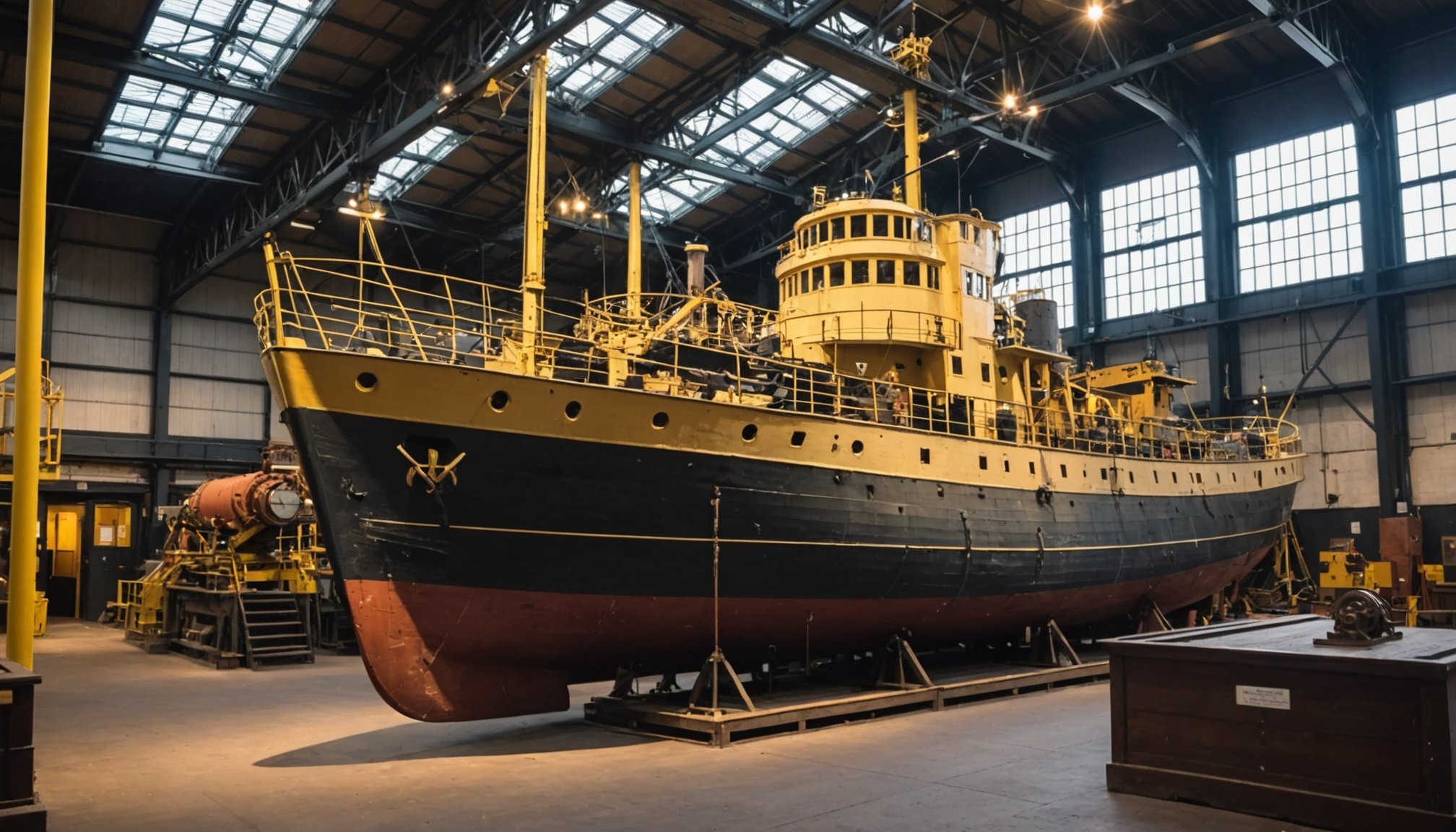Overview of Glasgow’s Historic Shipbuilding Museums
Glasgow has long been recognized for its significant role in the shipbuilding industry, contributing extensively to maritime advancements worldwide. The city’s rich shipbuilding history is beautifully preserved and showcased in several museums dedicated to this important aspect of Glasgow’s past.
Prominent amongst these are the Riverside Museum and the Tall Ship at Riverside, which stand out not only for their comprehensive exhibits but also for their striking architectural designs. These institutions serve as tributes to Glasgow’s vibrant industrial heritage, offering a deep dive into the artistic and engineering feats achieved in the shipyards.
Also to discover : Unveiling britain”s mystical stone circles: expert advice for an unforgettable exploration
Various shipbuilding museums across the city present options for both self-guided and guided tours. Guided tour experiences often vary, from in-depth explorations of the shipbuilding era to concise introductions perfect for the first-time visitor. Each museum’s guided tour offers a distinct narrative, catering to different interests and time constraints, ensuring everyone can appreciate Glasgow’s maritime legacy.
The knowledgeable guides enhance the experience, sharing insightful anecdotes and detailed interpretations of exhibits, making the guided tours both educational and engaging. Whether you’re a history enthusiast or a casual visitor, these museums promise a captivating journey through Glasgow’s shipbuilding history.
Topic to read : Explore the magical world of traditional english christmas markets: your complete guide to festive delights
Visitor Resources and Visuals
A well-prepared visit to Glasgow’s must-see museums begins with the right resources. For an optimal experience, visitors are encouraged to utilize maps and brochures available at museum entrances. These aids are indispensable for navigating between exhibits, ensuring you don’t miss any highlights. Many museums also offer digital resources, providing convenient access to additional information and interactive content that augments physical displays.
Furthermore, incorporating visuals has proven incredibly effective in enriching the visitor experience. From detailed models of historic shipyards to immersive audiovisual presentations, these elements vividly bring Glasgow’s maritime heritage to life. Films and recordings often accompany exhibits, offering contextual details and engaging storytelling that captivate audiences and enhance understanding.
Importantly, museums strive for inclusive visitor aids, such as enlarged text and audio guides, to accommodate various preferences and needs. This attentiveness not only fosters accessibility but ensures that every visitor can fully appreciate the stories behind Glasgow’s shipbuilding history. Audiovisual content goes beyond mere decoration; it forms an integral part of the narrative, creatively assembling visual experiences that transform historical facts into compelling stories. All these resources collectively contribute to creating a comprehensive and unforgettable journey through Glasgow’s past.
Guided Tour Highlights
For those eager to delve deeper into Glasgow’s shipbuilding history, guided tours offer an enriching experience. Such museum experiences present a spectrum of tour options, from short introductory sessions ideal for casual visits to comprehensive explorations tailored for history enthusiasts.
Expert guides, renowned for their expansive knowledge and engaging storytelling, make these tours truly memorable. Their insights provide a profound understanding of the exhibits and the city’s maritime legacy. Visitors often praise these guides in testimonials, highlighting their ability to bring history to life with vivid narratives and personal anecdotes.
Tour details vary; however, many include visits to meticulously restored shipyards and interactive exhibitions. This allows guests to appreciate the exquisite craftsmanship and technological advancements of Glasgow’s shipbuilding era. Some tours also offer a behind-the-scenes look, revealing fascinating stories that are not part of the regular display.
Whether you’re intrigued by engineering marvels or seeking a cultural journey, the guided tours cater to diverse interests. With flexible schedules and varied tour lengths, visitors can choose the experience that best fits their itinerary, ensuring a meaningful encounter with Glasgow’s shipbuilding heritage.
Must-See Museums
Embarking on a journey through Glasgow’s maritime heritage wouldn’t be complete without visiting its must-see museums. These establishments stand as vibrant testimonies to the city’s illustrious past in shipbuilding. Central to your exploration are the Riverside Museum and The Tall Ship at Riverside, both offering profound insights into the ingenuity of former shipyards.
Each museum boasts its unique features and attractions. The Riverside Museum, an award-winning architectural marvel, hosts an impressive array of over 3,000 exhibits that narrate the city’s transport history, deeply intertwined with its maritime exploits. Interactive displays, combined with immersive settings, bring tales of engineering advancements to life.
Meanwhile, The Tall Ship—an icon of the maritime history—resides adjacent to the museum. Visitors can explore this painstakingly restored, historic vessel in all its grandeur, offering a truly distinctive perspective.
The historical importance of the exhibits cannot be overstated. These displays are meticulously curated to showcase the dynamic evolution of shipbuilding and its monumental impact on Glasgow’s economy and industrial heritage. Whether it’s the craftsmanship of ship models or recreated dockyard scenes, these museums form the heart of Glasgow’s shipbuilding narrative.
Historical Context of Shipbuilding in Glasgow
Understanding Glasgow’s shipbuilding history provides insight into its profound industrial heritage. As a once-dominant force in the maritime industry, Glasgow was pivotal in advancing shipbuilding techniques and technologies. This transformation began in the late 18th century, with the Clyde River playing a crucial role due to its strategic location and access to resources.
Key events propelled the shipbuilding sector forward, notably during the 19th and early 20th centuries. Glasgow became known for constructing technologically advanced vessels, meeting global demand with innovative engineering. The introduction of steam power revolutionised shipbuilding, allowing the production of larger and faster ships, positioning the city at the forefront of maritime advancements.
The shipbuilding industry’s impact on Glasgow extended beyond economic growth. It shaped the city’s cultural and social dynamics, creating employment and fostering a sense of community. As shipyards expanded, entire neighbourhoods arose around them, embedded with rich traditions and histories.
Despite facing decline in the late 20th century due to global competition and economic shifts, shipbuilding remains an integral part of Glasgow’s identity. Today, the city honours this legacy through shipbuilding museums and guided tours, celebrating the achievements and contributions of this vibrant era.
Practical Visitor Information
Visiting Glasgow’s shipbuilding museums requires a bit of planning to make the most of this historical experience. Here are some practical visiting tips:
-
Opening hours generally vary, but most museums open around 10am and close by 5pm. It’s advisable to check individual museum timings beforehand, particularly during holidays.
-
With regard to ticket prices, these can range from free entry to a nominal fee. Tickets are available for purchase both online and at the museum entrance; buying online can help you avoid long queues.
-
For those driving, consider parking availability. Several museums provide public parking spaces, but they can fill up quickly, especially on weekends.
-
Accessibility is a major consideration, with many museums offering facilities such as wheelchair access and audio guides to ensure everyone can enjoy the exhibits.
-
Plan your visit around non-peak hours to enjoy a more leisurely exploration without the crowds. Early mornings are often the least crowded times.
By preparing ahead, you can ensure a smooth visit, fully immersing in Glasgow’s rich maritime history while comfortably navigating the city’s remarkable shipbuilding museums.
Economic Impact and Technological Advancements
Glasgow’s shipbuilding history stands as a testament to the city’s profound contributions to the maritime industry, facilitating technological advancements that reverberated worldwide. In its heyday, Glasgow was renowned for innovative engineering, particularly evident in the introduction of steam power, which revolutionised shipbuilding standards by enabling the production of larger and more efficient vessels.
The economic impact of this industry on Glasgow cannot be overstated. At its zenith, shipbuilding was a driving force behind the city’s economic boom, generating vast employment opportunities and fostering a strong community identity. Entire neighbourhoods emerged around bustling shipyards, developing rich cultural narratives closely linked to the maritime trade.
Despite facing stiff global competition and a downturn in the late 20th century, the legacy of shipbuilding remains a pivotal part of Glasgow’s identity. Today, this legacy is celebrated through various shipbuilding museums and guided tours, which aim to portray Glasgow’s rich industrial heritage and maritime history. The meticulous restoration of vessels and interactive exhibitions form a bridge between past innovations and present appreciation, ensuring visitors fully grasp the enduring significance of shipbuilding to Glasgow’s economic and cultural landscape.











